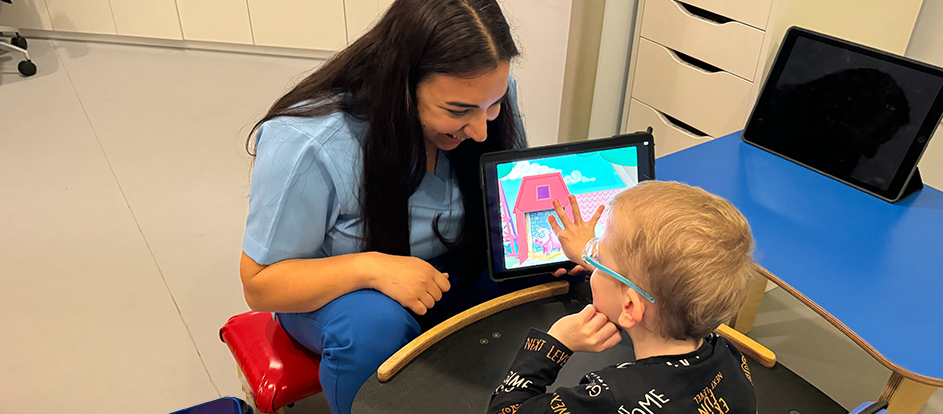

Unlocking Communication: The Power of AAC in Early Intervention

Chirine Schlink
Speech and Language Therapist Supervisor
DHA License Number: 23535515-003

Helping children communicate is one of the most important things parents and caregivers can do. Some children face challenges with speech and language, and that is where Augmentative and Alternative Communication (AAC) comes in. Many people think AAC is only for children who cannot speak, but that is not true. AAC is a key part of total communication, which means using all forms of communication together to help children express themselves and understand others. Let us explore how AAC (including gestures, pictures, and devices) can make a big difference for children and their families when combined with speech.
What is total communication and why is AAC an important part of it?
Total communication means using all possible ways to help a child communicate. This includes spoken words, gestures, facial expressions, sign language, pictures, and tools like communication boards or high-tech devices. AAC is a crucial part of total communication because it provides children more ways to express themselves, especially when speech is difficult.
Here is why AAC is important in total communication:
- Supports all kinds of learners
Every child is unique. Some children learn best by hearing words, while others may need to see or touch something to understand. AAC tools, like pictures or devices, make communication more accessible for everyone. - Works alongside verbal communication
AAC does not replace speech but works alongside it. For example, a child might say “juice” while pointing to a picture of a cup. Using both methods together strengthens their ability to communicate effectively. - Reduces frustration
When children struggle to communicate, they can become frustrated. By giving them multiple ways to express themselves, AAC and total communication help reduce tantrums and build confidence. - Encourages language growth
Using AAC alongside speech does not stop children from talking. In fact, it often helps them learn new words and concepts faster because they feel supported.
Clearing up myths about AAC
Parents often have questions or worries about AAC. Here are three common myths and the facts you should know:
Myth: AAC is only for children who cannot talk
Fact: AAC is for any child who needs help communicating. It can be used as an extra tool for children who are learning to talk or who sometimes find it hard to express themselves clearly.
Myth: Children who use AAC will not learn to talk
Fact: Research shows that AAC does not stop children from talking. Instead, it can help them use more words. When children feel successful communicating with AAC, they often become more interested in using their voice too.
Myth: AAC is too hard for young children
Fact: AAC can be simple! For young children, AAC might mean pointing to pictures or using gestures. As they grow, they can move to more advanced tools if needed. Starting early helps them get comfortable with AAC and total communication.
How to use total communication at home:
- Use AAC throughout the day
Include AAC in everyday activities. For example, during breakfast, use a picture board to let your child choose between cereal and toast. During playtime, point at pictures or use signs for toys and actions. - Model communication
Show your child how to use AAC by using it yourself. For instance, if your child has a communication device, press the buttons to say words while you talk. This teaches them how AAC works. - Mix and match communication methods
Encourage your child to use gestures, sounds, words, or AAC – whatever works best in the moment. Let them know it is okay to use different ways to communicate. - Celebrate every effort
Praise your child whenever they try to communicate, even if it is not perfect. Every attempt is a step towards stronger communication skills.
Why Start Early?
Starting AAC early gives children more time to practice and grow. Here are some benefits:
- Prevents communication frustration: When children have tools to express themselves, they feel less upset and more confident.
- Builds social skills: AAC helps children join conversations, make friends, and connect with family.
- Supports learning: Communication is the key to learning new things. AAC helps children ask questions, share ideas, and explore the world around them.
Final thoughts
Every child deserves the chance to communicate. AAC is a powerful tool that fits perfectly into the total communication approach, combining gestures, pictures, devices, and spoken words. By embracing AAC and total communication, parents can give their child the tools they need to connect with the world. Remember, communication is about connection and there is no one-size-fits-all approach. Celebrate your child’s unique way of communicating and enjoy the journey together.
Sources:
If you want to learn more about AAC and total communication, here are some helpful resources:
- Light, J. C., & McNaughton, D. (2012). Supporting the communication, language, and literacy development of children with complex communication needs. Assistive Technology, 24(1), 34–44.
- Romski, M. A., & Sevcik, R. A. (2005). Augmentative communication and early intervention: Myths and realities. Infants & Young Children, 18(3), 174–185.
- Beukelman, D. R., & Mirenda, P. (2013). Augmentative and alternative communication: Supporting children and adults with complex communication needs (4th ed.). Baltimore: Brookes Publishing.
- National Joint Committee for the Communication Needs of Persons with Severe Disabilities (NJC). (2003). Position statement on access to communication services and supports.


